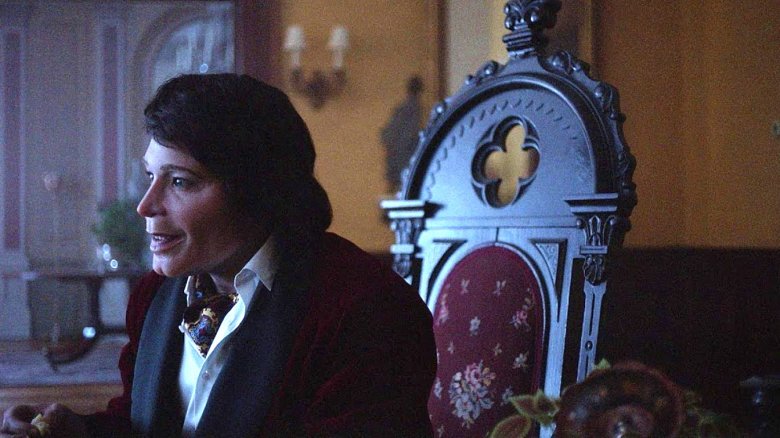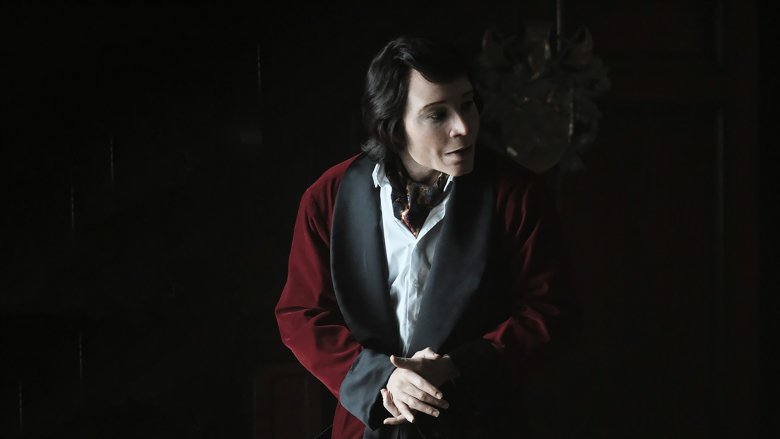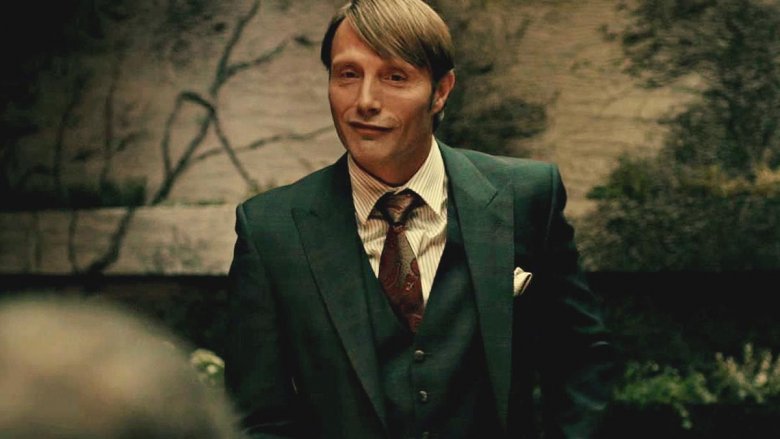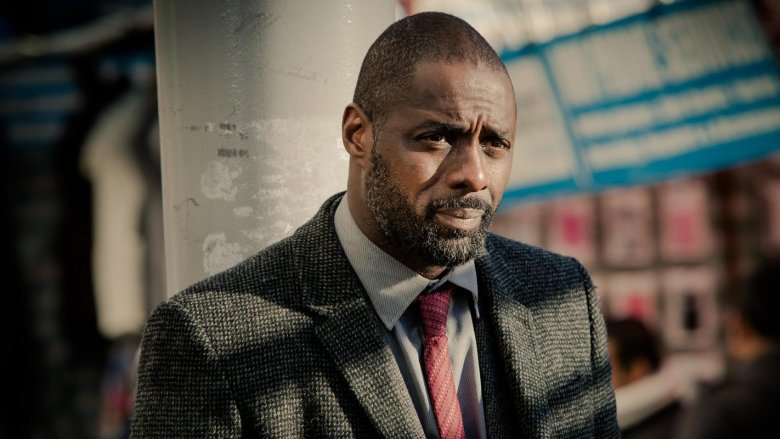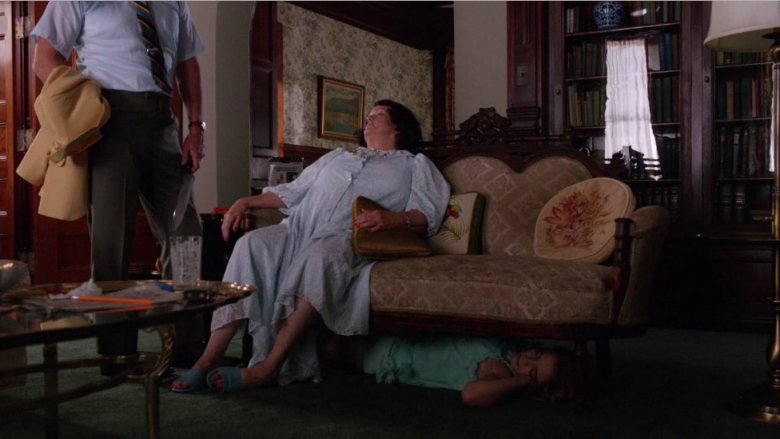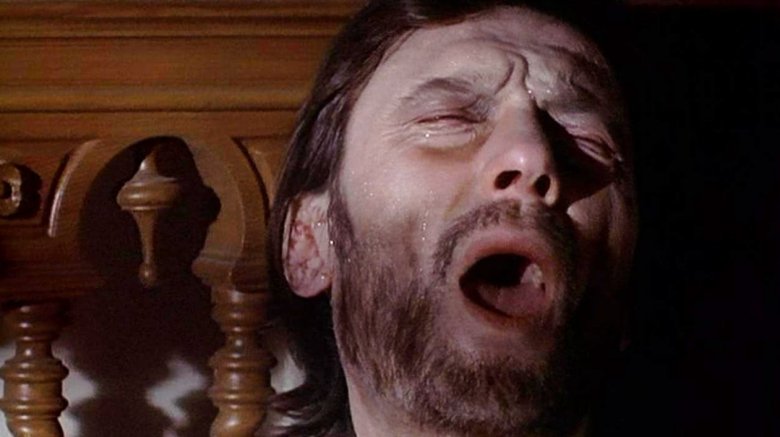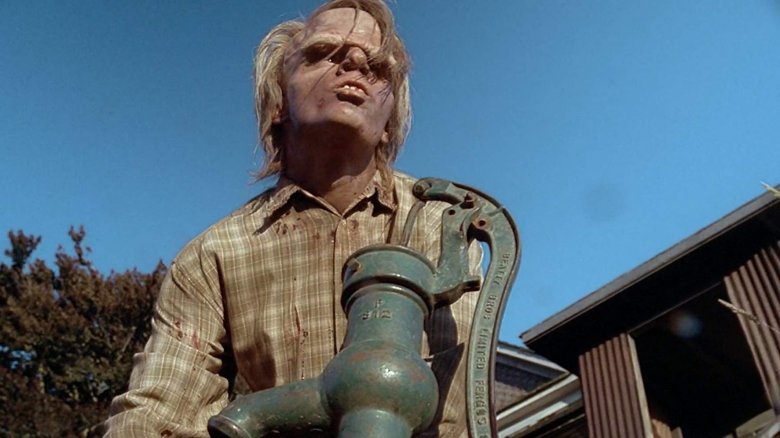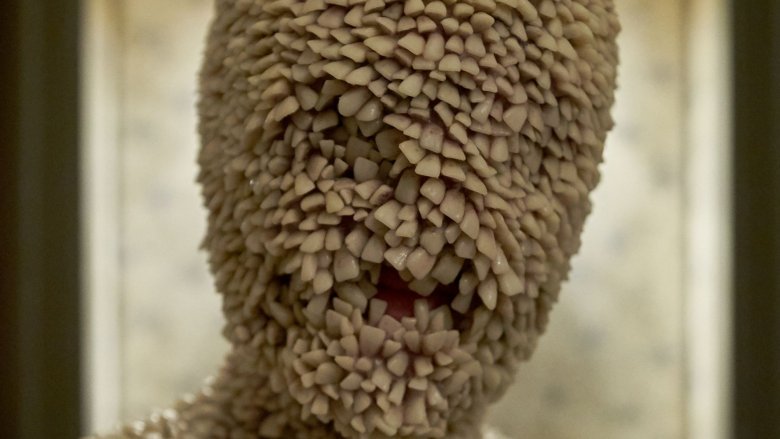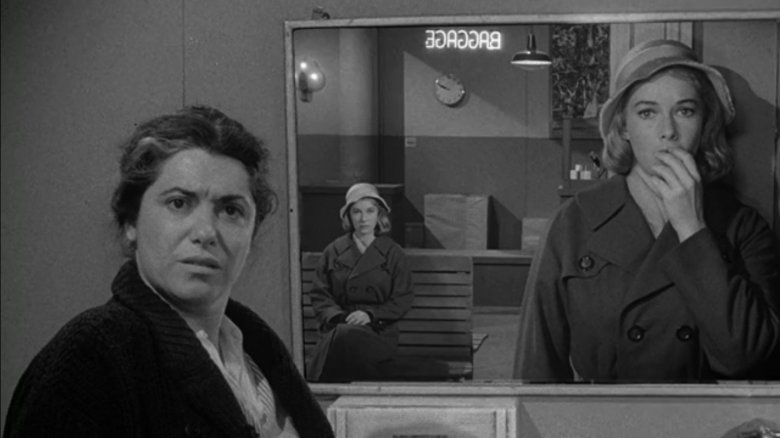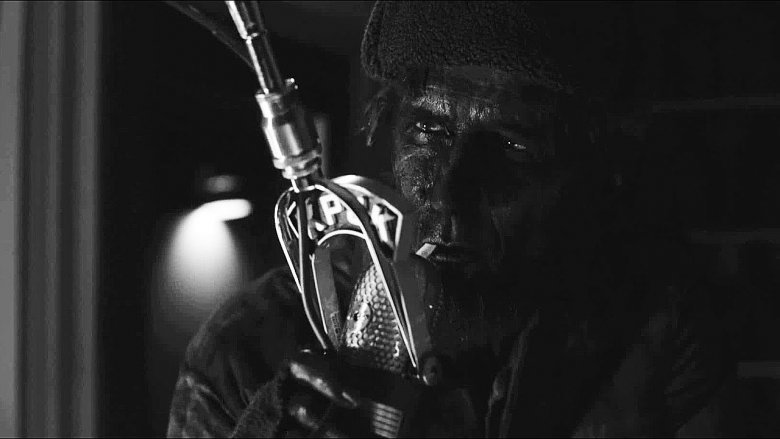Creepy TV Shows You Should Never Watch Alone
In a world where "Netflix cheating" is a real sin that can drive a wedge between even the strongest partners, it can occasionally be smarter to watch a show by yourself. That way, you don't need to worry about slowing your season-long binges or answer any questions from someone who wanders in halfway through an episode. Of course, there are some serious downsides to watching television alone, especially when you're watching shows that tend to veer more towards the spooks and frights than the wacky shenanigans of The Office.
Even shows that aren't usually grouped within the horror genre can have one-off episodes that are absolutely terrifying, and the last thing you want to do is look up from a particularly scary episode only to find yourself completely alone in a newly-spooky house. From a pinwheel of corpses to the raw existential terror of the nuclear bomb, here are the television episodes you should never watch alone.
The scariest man in Atlanta
Despite creator Donald Glover calling it "Twin Peaks for rappers," Atlanta doesn't usually venture into full dread and surreal horror — if anything, Glover's buzzword-ready manifesto could more easily be read as an indication of how weird and idiosyncratic Atlanta can get. But "Teddy Perkins," the sixth episode of the second season, stands alone as one of the scariest and most dread-inducing episodes of anything on television. The episode is ostensibly about Darius (Lakeith Stanfield) picking up a free piano from an eccentric recluse, but that plot summary doesn't begin to cover the slow, creeping dread that begins when Darius meets Teddy Perkins.
As Darius continues to ignore every warning sign (including actual warnings from his friends to get out of the house), you become transfixed at how the story is going to play out. The episode is packed with references ranging from Michael Jackson to Misery to Whatever Happened to Baby Jane?, but at its core "Teddy Perkins" is about trauma and abuse — scary themes even before Teddy Perkins fixes his shark-like eyes on you. By the end of it, you'll be checking your basement and attic just to make sure no one's in there.
I spy with my giant corpse eye
For three seasons, Hannibal was one of the most darkly horrifying television shows to air on network television. An adaptation of Thomas Harris' Hannibal Lecter series of books, Hannibal starred Mads Mikkelsen as the titular cannibal serial killer. Pretty much every episode of the show could easily qualify as something you really don't want to watch alone, but "Sakizuki," the second episode of season two, might take the cake for most terrifying.
The episode begins with a nameless man who wakes up in a grain silo after being sewn into a grotesque pinwheel of corpses. After straining, he's able to rip out the stitches and escape into a corn field — before eventually smashing his head on a rock after leaping into a river. Hannibal was always able to find a morbid beauty in the various serial killers' "grand designs," but "Sakizuki" is all the more horrifying for how long we watch someone struggle to live... only to die regardless of his efforts. It's a stunningly scary opening, and it only gets worse as you watch the rest of the episode feature even more visuals of the corpse "painting" that opened the episode.
Check under the bed
If you only know Idris Elba from his film roles, then you're missing out on one of his absolute best performances as the grizzled genius detective John Luther in Luther. Despite the show's focus on serial killers, Luther is more often focused on the psychological underpinnings of why the killers are haunting the streets of London than the grisly results of their activities. Still, even while the show isn't quite horror, there are some extremely scary moments. Easily topping the list is the opening scene of season three, episode one, which features a serial killer that lurks inside people's homes before killing them.
If you're watching home alone, it's going to be nearly impossible for you not to triple check under your bed after watching the killer slowly crawl out from under the bed in the opening minutes. It's the slow, easy way he slides out that's so scary, and it's an image that will haunt you long after you turn off the TV.
It's a mad, mad man
If Mad Men is known for any sort of scariness, it's the slow, existential horror of watching the racist and sexist societal mores of '50s America weigh down on characters. "Mystery Date," however, delves fully into the kind of paranoia-wrought fears that make movies like Rosemary's Baby so unsettling. That's no coincidence, either: showrunner Matthew Weiner compared the episode to a horror movie.
The episode follows various characters as they all react with varying levels of terror to the news of the real-life Richard Speck murders in Chicago. In the case of Don Draper (Jon Hamm), it leads to one of the most horrifying moments for the show's extremely flawed protagonist as he becomes so delusional with fever that he dreams of strangling one of his old paramours to death. Although that's the most viscerally upsetting thing to happen in the episode, each of the episode's main threads involve the fear of betrayal and murder — one horrifying visual involves Sally's step-grandmother asleep on the couch with a butcher knife in her hand. The entire episode takes on such an aura of dread that you'll be double checking the locks on all your doors and windows before you sleep — made even worse by how unexpected the show's brief foray into horror is.
Don't get wigged out
Chances are pretty good that sometime during your childhood, a kid told you that earwigs would crawl into your ear, get stuck, and be forced to crawl through your brain until it ate its way to your other ear. Like Bloody Mary or the uncle who works at Nintendo, it's the kind of schoolyard lie that pops up everywhere. Unfortunately, while schoolyard tales might have made the story of a bug trapped inside your brain sound scary, that's nothing compared to "The Caterpillar," an episode of Night Gallery that shows you in gruesome detail exactly how awful it would be.
Night Gallery was an anthology series hosted (and occasionally written) by Rod Serling as a more supernatural-themed follow-up to The Twilight Zone. But while The Twilight Zone occasionally veered into horror, Night Gallery seemed to relish the puritanical and supernatural punishments it dispensed to its greedy and thoughtless protagonists. "The Caterpillar" sees Steven Macy (Laurence Harvey) try to kill his boss in order to seduce the man's wife. He hires someone to put an earwig in his boss' ear, but as you might imagine, it doesn't go smoothly — and the episode's end offers one of the most gruesome, horrific twists that Serling would ever write.
There's no place like home
The X-Files might have said "I want to believe," but "Home" encouraged viewers to say "I absolutely do not want to believe." While some episodes of The X-Files involved far-out conspiracies and alien races, "Home" follows something much more mundane and much more frightening: the pervasive ability of human beings to inflict violence on one another.
The story follows Dana Scully (Gillian Anderson) and Fox Mulder (David Duchovny) as they investigate a dead baby found buried in a baseball field. What they find is so shocking and upsetting that it was banned from television for three years. The scariest thing about "Home" is how consistently nonchalant the Peacocks are about their many years of inbreeding and violence; at their core remains a shocking absence of morality anchored only by violence. Even for a show that involved a cancer-eating immortal and a virtual reality killer, the scariest thing to ever appear in The X-Files was the acknowledgement that regular people were the most violent and dangerous creatures on earth.
Television that is bad for you
Channel Zero is a show that adapts "Creepypastas" into full-length seasons of television. Creepypastas are internet horror stories that usually center around technology and the internet — Slenderman is arguably one of the most well-known examples. The first season, Candle Cove, was based on a short story by Kris Straub that takes the form of various forum posters reminiscing about a scary puppet show that they watched when they were kids. The Creepypasta is fairly short and hinges largely on the twist ending that there wasn't actually a puppet show — it was just various children staring at the dead air of a television screen.
It's the kind of twist that works best in a short burst, and one clever thing that Channel Zero does is adapt that conversation relatively early in the first episode. The rest of the episode shows exactly why the television adaptation stands alone from the Creepypasta it's based on by showing viewers The Tooth Child, a hideous creature made entirely of the teeth it steals from children. It's one of the scariest visuals to ever air on television, and the sound design of the click-clack of its movement makes it even worse. You definitely won't be sleeping after you see it.
Me, me, and also me
The scariest thing about The Twilight Zone is the way that it was able to tap into the primal fears at the root of our subconscious. Fears like our own hideousness, about being pawns of more powerful beings, of loneliness. "Mirror Image" taps into the very particular fear that you'll one day meet your own doppelganger. The episode follows Millicent Barnes (Vera Miles) as she spots a reflection of herself sitting at a bench — a separate reflection from the one she sees in the mirror. She continues to see her duplicate as she boards a bus, and Millicent begins to believe that the duplicate is from a parallel reality and can only survive by killing her off.
It's heady stuff, all anchored by Rod Serling's inimitable narration and writing, but the episode's careful cinematography basically guarantees that you'll be checking the mirror to make sure that you're the only "you" in sight. You definitely shouldn't watch this episode alone, but if you have an identical twin, maybe don't invite them either.
An atomic horror
Despite being one of the few directors whose very name has become a style of filmmaking, there really is no one quite like David Lynch. The original Twin Peaks has exerted its influence on television for over 20 years, with its mix of small-town intrigue and surreal characters, and it's just as likely that Twin Peaks: The Return will be likewise influential for the next two decades. All the proof you need is right there in Part 8 — a jaw-dropping work of art, so packed with subtextual horror that you might not even know why you're scared.
A plot summary of the episode would be worthless, but here are some of the incredible visuals on display: a nuclear bomb exploding like you've never seen it before; the cosmic horror that emerges as if the explosion opened up Hell itself; a man covered in soot (or maybe blood) belting out a melodic phrase as he crushes a man's skull in his hands; a horrifying mix of frog and bug that crawls down a young girl's throat. Lynch has always been known as someone uniquely able to tap into the surreal terror of waking up from a nightmare, but Part 8 proved just how much that oft-repeated praise is true. You've never seen anything quite like this episode, and you're going to want to make sure you've got a buddy to pull you out of the existential horror you'll drift into once you've finished it.
